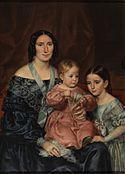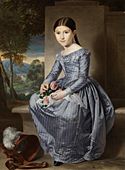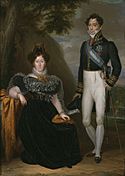Rafael Tegeo facts for kids
Rafael Tegeo Díaz (born November 27, 1798, in Caravaca de la Cruz; died October 3, 1856, in Madrid) was a famous Spanish painter. He is best known for his beautiful portraits. Rafael Tegeo painted in the Neoclassical style, which was popular at the time. Sometimes, his name is spelled Tejeo.
Contents
Life and Art of Rafael Tegeo
Early Life and Training
Rafael Tegeo was born into a family of skilled craftspeople. From a young age, he showed a great talent for drawing. He began his art studies at the "Real Sociedad de Amigos del País" in Murcia. There, an Italian sculptor named Santiago Baglietto taught him about Greek sculpture.
Later, a wealthy supporter, the Marqués de San Mamés, helped him. This support allowed Rafael to attend the important Real Academia de Bellas Artes de San Fernando in Madrid. At the Academy, he learned from well-known artists like José Aparicio and Fernando Brambila.
Studying in Rome
In 1824, Rafael Tegeo received a special scholarship to study art in Rome, Italy. This was a big opportunity for young artists. In Rome, he learned from famous painters such as Pietro Benvenuti and Vincenzo Camuccini.
While in Rome, he was greatly inspired by the works of master painters like Raphael and Guido Reni. He sent many of his paintings back to Spain for exhibitions. In 1828, he was recognized as an "Academician" for his painting of Hercules and Antaeus. This was a high honor for an artist.
Painting Mythology and History
At first, Rafael Tegeo focused on painting scenes from ancient myths. He created large wall paintings, called murals, in important buildings. These included the Palacio Real (Royal Palace), the Casino de la Reina, and the Palacio de Vista Alegre.
He also painted historical events sometimes. One famous historical painting shows a scene from the Siege of Málaga, which is also in the Palacio Real.
Becoming a Portrait Painter
Even though he painted myths and history, Rafael Tegeo became most famous for his portraits. He painted many important people, including Francis, Duke of Cádiz and Queen Isabel II. Because of these royal portraits, he was appointed as a court painter. This meant he was the official painter for the royal family.
He painted not only kings and queens but also wealthy citizens. He also created a series of portraits of famous Admirals and other officials from the Spanish Navy. These paintings can now be seen at the Museo Naval de Madrid.
Later Career and Legacy
In 1839, Rafael Tegeo became the Deputy Director of painting at the Academia where he once studied. Three years later, he was made Honorary Director. He held this important position until he resigned in 1846. His last major art show was at the Exposition Universelle (1855) in Paris.
Today, the street where Rafael Tegeo was born in Caravaca de la Cruz is named in his honor. In 2015, the local government, the Ayuntamiento of Caravaca, announced a new book about him. The book, called Rafael Tegeo: Del tema clásico al retrato romántico, was written by Martín Páez Burruezo.
Selected Portraits
See also
 In Spanish: Rafael Tegeo para niños
In Spanish: Rafael Tegeo para niños






